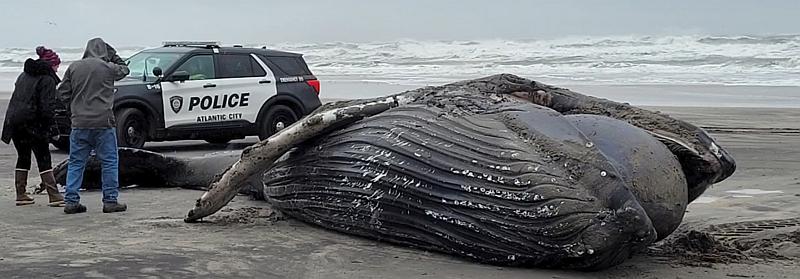
The dead whales have prompted several New Jersey GOP lawmakers to question whether the deaths were linked to the future development of a major proposed offshore wind farm in the area. Fox News host Tucker Carlson went further, blaming the wind project for the death of the whales and calling offshore wind “the DDT of our times.”
But scientists say there’s no evidence to support a connection between whale mortality and the development of offshore wind farms.
A preliminary necropsy on two humpback whales conducted by scientists at the Marine Mammal Stranding Center found the whales “suffered blunt trauma injuries consistent with those from a vessel strike.” Officials from the National Oceanic and Atmospheric Administration and the Bureau of Ocean Management told reporters no whale deaths have been attributed to offshore wind projects to date.
“There are no known connections between any of these offshore wind activities and any whale strandings, regardless of species,” said Benjamin Laws, deputy chief for the permits and conservation division with the NOAA Fisheries Office of Protected Resources.
Laws also said speculation that the sonar equipment wind companies use to map the ocean floor could have fatally harmed the whales has also not been proven. Officials noted the New Jersey wind energy project is prohibited from using levels of sonar so loud they could be fatal to whales or other marine life.
“There is no information that would support any suggestion that any of the equipment that’s being used in support of wind development for the site characterization surveys could directly lead to the death of a whale,” Laws said.
The deaths of humpbacks and other whales predate the recent deaths in New York and New Jersey waters and are geographically more widespread. Since 2016, scientists have been tracking elevated numbers of humpback whale deaths on the East Coast. From Maine to Florida, 178 whales have died. Scientists have examined about half of the incidents. Of those, about 40% were because whales were struck by ships or were entangled in fishing gear.
At any given time, 50 or more vessels, ranging from massive cargo ships to small fishing boats, are motoring off New Jersey’s 127-mile coast from New York to Delaware. In January, however, there was only one offshore wind surveying vessel in the area operating for a total of seven days.
Walt Nadolny, a professor emeritus at SUNY Maritime College in New York, has been teaching students for two decades how to avoid whale strikes before they head to sea as merchant mariners.
“The odds are ridiculously low” that the whales struck a slow-going survey vessel, said Nadolny, who has no affiliation with an offshore wind company.
Nadonly surmises that it’s highly unlikely an offshore wind surveying vessel, which normally would travel at 8 to 10 knots (9-11 mph), could cause a fatal blow to a whale. Rather, he said, fatal collisions typically occur with bigger ships traveling at least 18 knots (21 mph) or more. Usually, only large commercial ships travel that fast.
The National Oceanic and Atmospheric Administration (NOAA) has published frequently asked questions about interactions between offshore wind energy projects and whales on the East Coast. These include:
Is U.S. offshore wind development linked to any whale deaths?
No. At NOAA Fisheries, we work with our partners to analyze and understand the causes of death when we are able, following the science and data. At this point, there is no evidence to support speculation that noise resulting from wind development-related site characterization surveys could potentially cause the mortality of whales. There are no specific links between recent large whale mortalities and currently ongoing surveys for offshore wind development. We will continue to gather data to help us determine the cause of death for these mortality events.
What is the cause of recent whale deaths off New York and New Jersey? Is it related to offshore wind development?
No, it is not related to offshore wind development. Since January 2016, NOAA Fisheries has been monitoring an Unusual Mortality Event for humpback whales with elevated strandings along the entire East Coast. To date, there are 178 humpback whale mortalities included in the UME. Partial or full necropsy examinations were conducted on approximately half of the whales. Of the whales examined, about 40 percent had evidence of human interaction, either ship strike or entanglement. Vessel strikes and entanglement in fishing gear are the greatest human threats to large whales.
Why is there currently a high number of large whales in the waters off New Jersey? Is it related to offshore wind?
As the humpback whale population has grown, they are seen more often in the Mid-Atlantic. Along the New Jersey shore, these whales may be following their prey (small fish) which are reportedly close to shore this winter. These prey also attract fish that are of interest to recreational and commercial fishermen. This increases the number of boats in these areas. More whales in the water in areas traveled by boats of all sizes increases the risk of vessel strikes.
Reference: oldsaltblog.com

